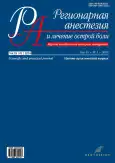Comparative evaluation of two methods of prolonged femoral nerve block using an elastomeric pump after knee arthroplasty: a prospective randomized controlled study
- Authors: Krylov S.V.1,2, Pasechnik I.N.2
-
Affiliations:
- Priorov National Medical Research Center of Traumatology and Orthopedics
- Central State Medical Academy
- Issue: Vol 18, No 1 (2024)
- Pages: 53-62
- Section: Original articles
- URL: https://journals.rcsi.science/1993-6508/article/view/257408
- DOI: https://doi.org/10.17816/RA623946
- ID: 257408
Cite item
Abstract
BACKGROUND: The number of knee arthroplasty (KA) surgeries is increasing annually. These surgeries are associated with severe pain. The optimal method of choice in perioperative analgesia in these patients remains controversial. The use of regional analgesia, including prolonged analgesia, allows for high pain relief and increased patient satisfaction. Modern elastomeric pumps (EP) provide prolonged conduction analgesia, which significantly expands the possibilities of perioperative pain relief.
OBJECTIVE: To evaluate the effectiveness of prolonged femoral nerve block using EP with and without bolus after KA.
MATERIALS AND METHODS: This prospective randomized study included 75 patients who were divided into two clinical groups: group 1 (n=36), patients who received prolonged regional analgesia using EP with controlled injection without bolus, and group 2 (n=39), patients who received prolonged regional analgesia using EP with bolus. In the postoperative period, the level of pain at rest and during movement was assessed after 6, 12, 24, and 48 hours as well as the need for opioid analgesics, consumption of local anesthetic for various options of continued regional analgesia, quadriceps femoris muscle function, and distance traveled by patients after surgery in the first 2 days.
RESULTS: No significant differences were noted in pain level at rest and during movement in the observation period between the groups (p=0.213). No additional prescription of opioid analgesics was required. Local anesthetic consumption was lower in group 2 (group 1.384±33.4 ml; group 2.237±25.1 ml; p=0.031). Patients in group 2 had greater activity in knee extension and, thus, greater distance traveled after surgery.
CONCLUSION: The use of EP with a bolus has been demonstrated to provide adequate levels of analgesia and better functional recovery in patients with bolus after KA than in patients without bolus. This technique is recommended as a component of enhanced recovery program after surgery.
Keywords
Full Text
##article.viewOnOriginalSite##About the authors
Sergey V. Krylov
Priorov National Medical Research Center of Traumatology and Orthopedics; Central State Medical Academy
Author for correspondence.
Email: doc087@inbox.ru
ORCID iD: 0000-0001-7755-7163
SPIN-code: 4067-1787
MD, Cand. Sci. (Medicine)
Russian Federation, Moscow; MoscowIgor N. Pasechnik
Central State Medical Academy
Email: pasigor@yandex.ru
ORCID iD: 0000-0002-8121-4160
SPIN-code: 4433-1418
MD, Dr. Sci. (Medicine), professor
Russian Federation, MoscowReferences
- Brander V, Stulberg SD. Rehabilitation after hip- and knee-joint replacement. An experience- and evidence-based approach to care. Am J Phys Med Rehabil. 2006;85(11 Suppl):S98–S118; quiz S119–S123. doi: 10.1097/01.phm.0000245569.70723.9d
- Zhu S, Qian W, Jiang C, et al. Enhanced recovery after surgery for hip and knee arthroplasty: a systematic review and meta-analysis. Postgrad Med J. 2017;93(1106):736–742. doi: 10.1136/postgradmedj-2017-134991
- Grape S, Kirkham KR, Baeriswyl M, Albrecht E. The analgesic efficacy of sciatic nerve block in addition to femoral nerve block in patients undergoing total knee arthroplasty: a systematic review and meta-analysis. Anaesthesia. 2016;71(10):1198–1209. doi: 10.1111/anae.13568
- Kandarian BS, Elkassabany NM, Tamboli M, Mariano ER. Updates on multimodal analgesia and regional anesthesia for total knee arthroplasty patients. Best Pract Res Clin Anaesthesiol. 2019;33(1):111–123. doi: 10.1016/j.bpa.2019.02.004
- Ilfeld BM, Gabriel RA. Basal infusion versus intermittent boluses for perineural catheters: should we take the ‘continuous’ out of ‘continuous peripheral nerve blocks’? Reg Anesth Pain Med. 2019;44(3):285–286. doi: 10.1136/rapm-2018-100262
- Machi AT, Ilfeld BM. Continuous peripheral nerve blocks in the ambulatory setting: an update of the published evidence. Curr Opin Anaesthesiol. 2015;28(6):648–655. doi: 10.1097/ACO.0000000000000254
- Krylov SV, Pasechnik IN. Comparative evaluation of the use of femoral nerve block and adductor canal as a component of early patient activation after knee arthroplasty. Regional Anesthesia and Acute Pain Management. 2021;15(4):257–265. (In Russ). doi: 10.17816/RA107978
- Bendtsen TF, Moriggl B, Chan V, Børglum J. The Optimal Analgesic Block for Total Knee Arthroplasty. Reg Anesth Pain Med. 2016;41(6):711–719. doi: 10.1097/AAP.0000000000000485
- Charous MT, Madison SJ, Suresh PJ, et al. Continuous femoral nerve blocks: varying local anesthetic delivery method (bolus versus basal) to minimize quadriceps motor block while maintaining sensory block. Anesthesiology. 2011;115(4):774–781. doi: 10.1097/ALN.0b013e3182124dc6
- Galitzine S. Postoperative pain management for total knee and hip replacement. The 34th Annual European Society of Regional Anaesthesia & Pain Therapy (ESRA) Congress. 2015. P. 2–5.
- Runge C, Børglum J, Jensen JM, et al. The Analgesic Effect of Obturator Nerve Block Added to a Femoral Triangle Block After Total Knee Arthroplasty: A Randomized Controlled Trial. Reg Anesth Pain Med. 2016;41(4):445–451. doi: 10.1097/AAP.0000000000000406
- Kopp SL, Børglum J, Buvanendran A, et al. Anesthesia and Analgesia Practice Pathway Options for Total Knee Arthroplasty: An Evidence-Based Review by the American and European Societies of Regional Anesthesia and Pain Medicine. Reg Anesth Pain Med. 2017;42(6):683–697. doi: 10.1097/AAP.0000000000000673
- Aguirre J, Del Moral A, Cobo I, et al. The role of continuous peripheral nerve blocks. Anesthesiol Res Pract. 2012;(2012):560879. doi: 10.1155/2012/560879
Supplementary files












